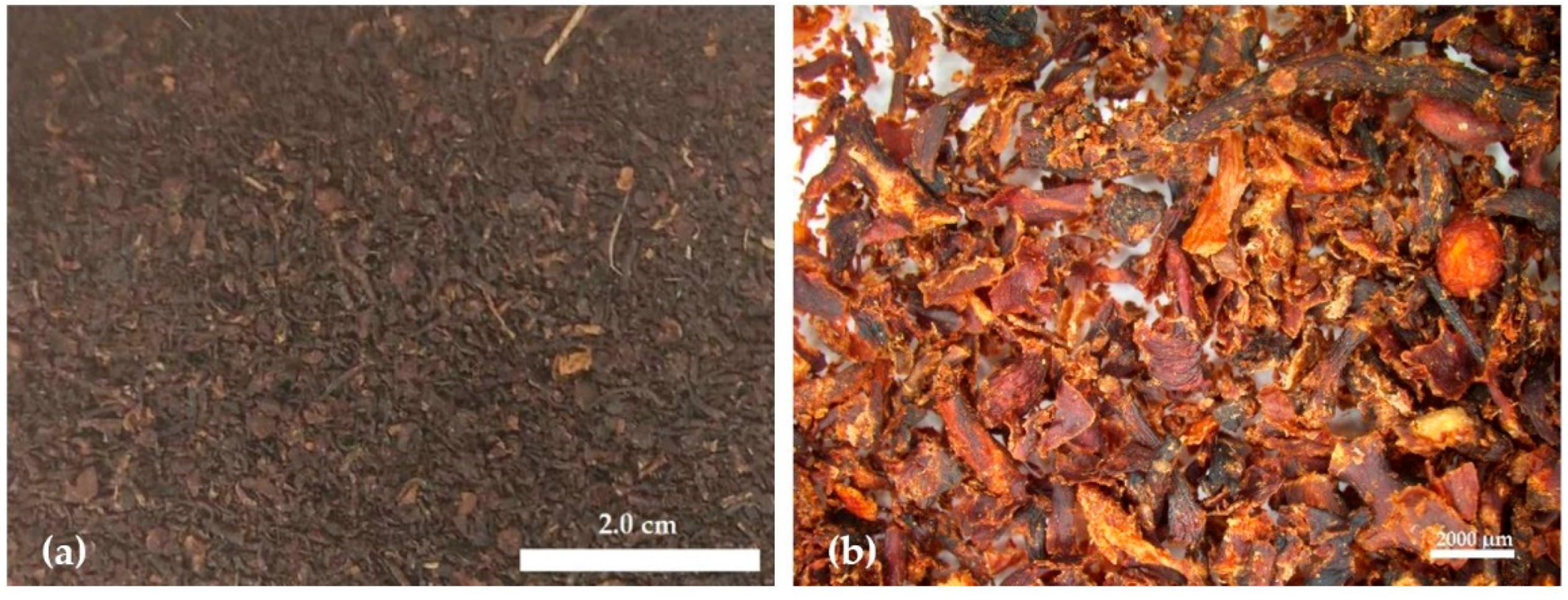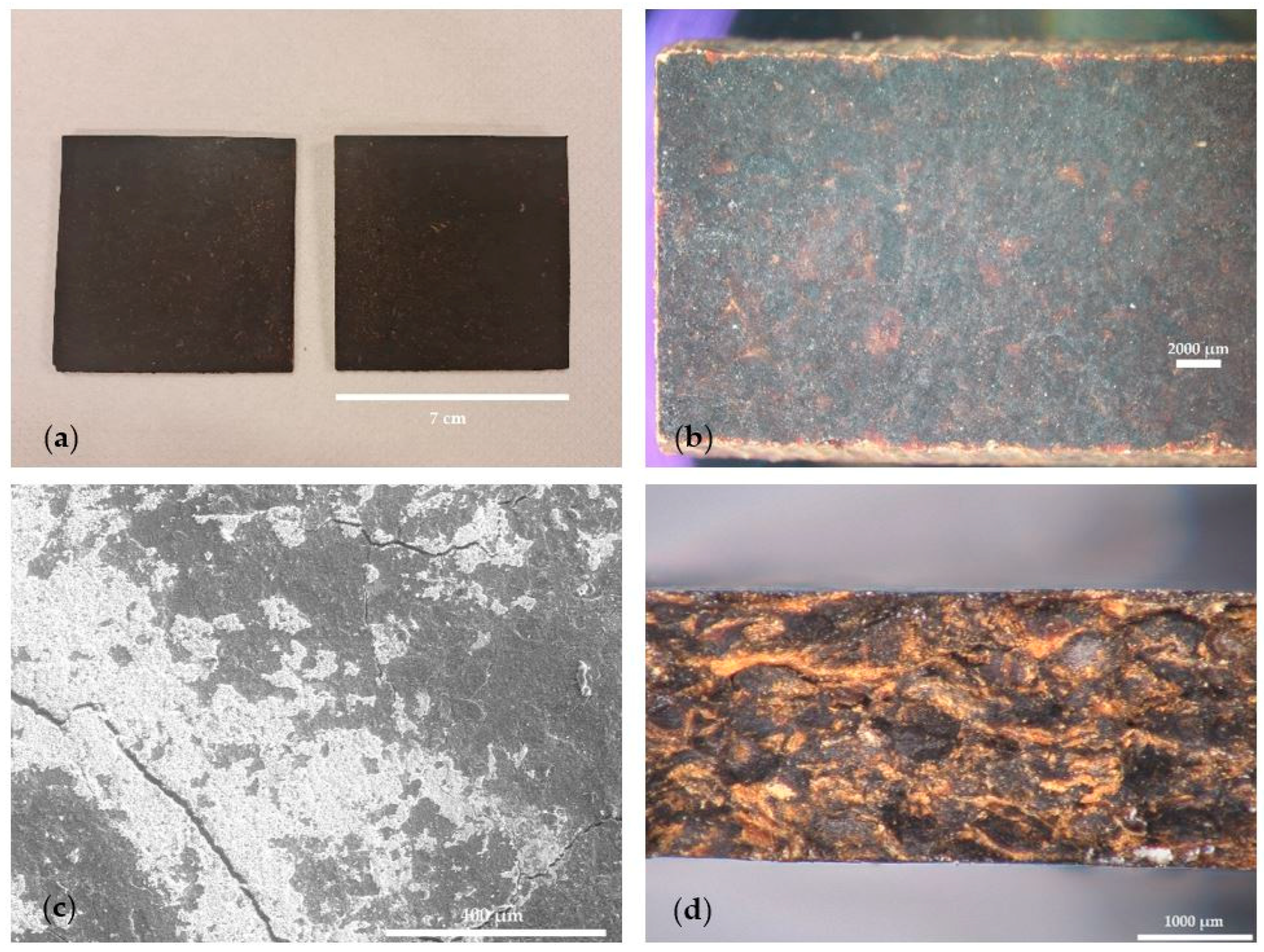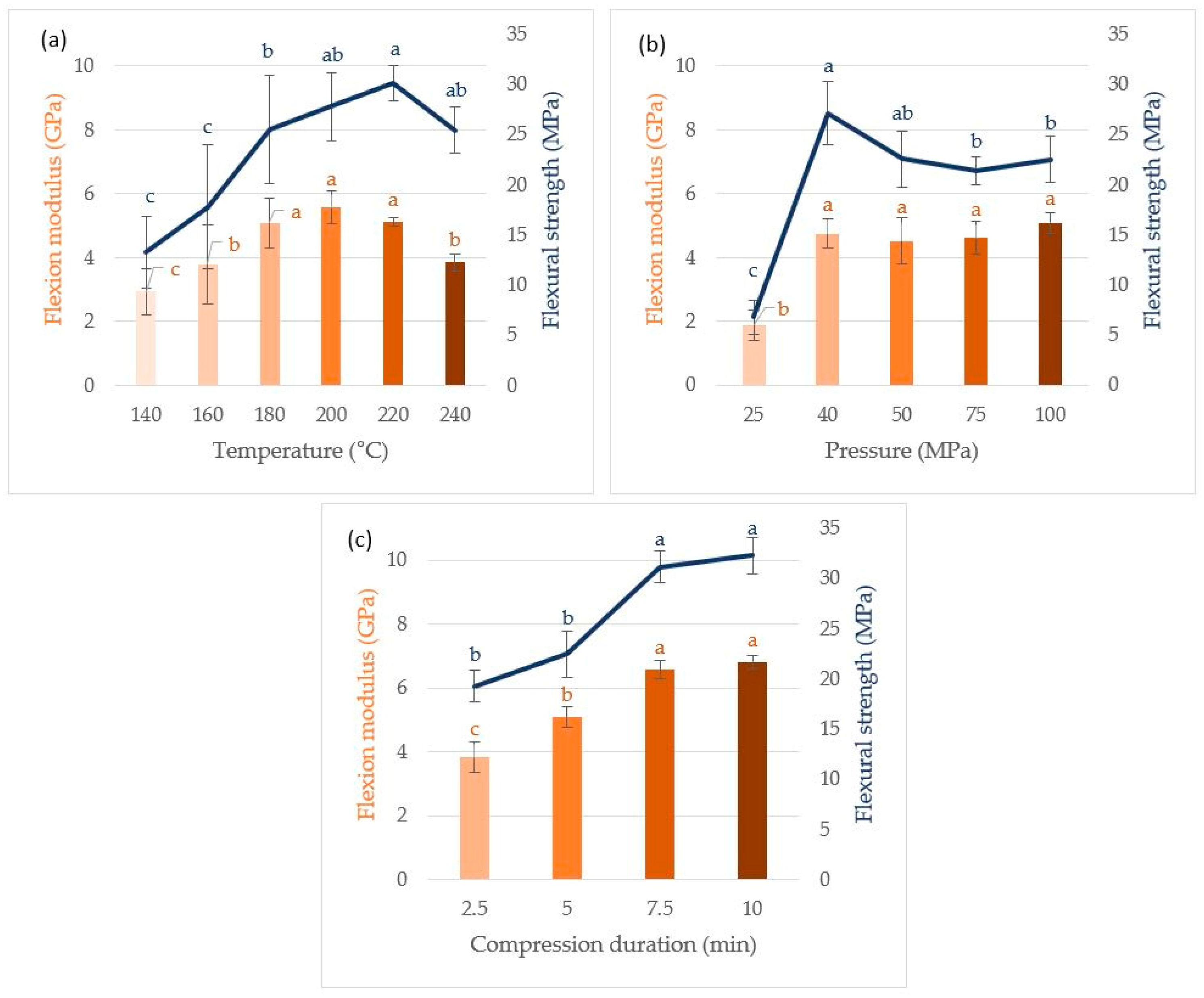Development of a Binderless Particleboard from Brown Seaweed Sargassum spp.
Abstract
:1. Introduction
2. Materials and Methods
2.1. Sample Preparation
2.2. Thermo-Compression
2.3. Characterization of Extrudate and Materials
3. Results and Discussion
3.1. Characterization of the Raw Seaweeds and Extrudate
3.2. Study of Thermo-Compression Experimental Parameters of Sargassum Extrudate
3.3. Impact of Experimental Conditions on Density
3.4. Role of Alginates during Thermo-Compression Process of Sargassum Particleboard
4. Conclusions
Supplementary Materials
Author Contributions
Funding
Institutional Review Board Statement
Informed Consent Statement
Data Availability Statement
Conflicts of Interest
References
- Wang, M.; Hu, C.; Barnes, B.B.; Mitchum, G.; Lapointe, B.; Montoya, J.P. The Great Atlantic Sargassum Belt. Science 2019, 365, 83–87. [Google Scholar] [CrossRef] [PubMed]
- López Miranda, J.L.; Celis, L.B.; Estévez, M.; Chávez, V.; van Tussenbroek, B.I.; Uribe-Martínez, A.; Cuevas, E.; Rosillo Pantoja, I.; Masia, L.; Cauich-Kantun, C.; et al. Commercial Potential of Pelagic Sargassum Spp. in Mexico. Front. Mar. Sci. 2021, 8, 768470. [Google Scholar] [CrossRef]
- Agence Nationale de Sécurité Sanitaire Alimentation, Environnement, Travail (ANSES). Expositions aux Émanations d’algues Sargasses en Décomposition au Antilles et en Guyane. [PDF online]. 2017. Available online: https://www.anses.fr/fr/system/files/AIR2015SA0225Ra.pdf (accessed on 19 December 2023).
- Resiere, D.; Mehdaoui, H.; Florentin, J.; Gueye, P.; Lebrun, T.; Blateau, A.; Viguier, J.; Valentino, R.; Brouste, Y.; Kallel, H.; et al. Sargassum Seaweed Health Menace in the Caribbean: Clinical Characteristics of a Population Exposed to Hydrogen Sulfide during the 2018 Massive Stranding. Clin. Toxicol. 2020, 59, 1789162. [Google Scholar] [CrossRef] [PubMed]
- van Tussenbroek, B.I.; Hernández Arana, H.A.; Rodríguez-Martínez, R.E.; Espinoza-Avalos, J.; Canizales-Flores, H.M.; González-Godoy, C.E.; Barba-Santos, M.G.; Vega-Zepeda, A.; Collado-Vides, L. Severe Impacts of Brown Tides Caused by Sargassum Spp. on near-Shore Caribbean Seagrass Communities. Mar. Pollut. Bull. 2017, 122, 272–281. [Google Scholar] [CrossRef] [PubMed]
- Hendy, I.W.; Woolford, K.; Vincent-Piper, A.; Burt, O.; Schaefer, M.; Cragg, S.M.; Sanchez-Navarro, P.; Ragazzola, F. Climate-Driven Golden Tides Are Reshaping Coastal Communities in Quintana Roo, Mexico. Clim. Change Ecol. 2021, 2, 100033. [Google Scholar] [CrossRef]
- Rodríguez-Martínez, R.E.; Medina-Valmaseda, A.E.; Blanchon, P.; Monroy-Velázquez, L.V.; Almazán-Becerril, A.; Delgado-Pech, B.; Vásquez-Yeomans, L.; Francisco, V.; García-Rivas, M.C. Faunal Mortality Associated with Massive Beaching and Decomposition of Pelagic Sargassum. Mar. Pollut. Bull. 2019, 146, 201–205. [Google Scholar] [CrossRef] [PubMed]
- Dolique, F.; Sédrati, M.; Josso, Q. Impact des laisses végétales sur la dynamique des plages sableuses, Martinique, Petites Antilles. VVertigO-La Rev. Électronique En Sci. L’environnement 2021, 21, 1–19. [Google Scholar] [CrossRef]
- Chávez, V.; Uribe-Martínez, A.; Cuevas, E.; Rodríguez-Martínez, R.E.; van Tussenbroek, B.I.; Francisco, V.; Estévez, M.; Celis, L.B.; Monroy-Velázquez, L.V.; Leal-Bautista, R.; et al. Massive Influx of Pelagic Sargassum Spp. on the Coasts of the Mexican Caribbean 2014–2020: Challenges and Opportunities. Water 2020, 12, 2908. [Google Scholar] [CrossRef]
- Ahmed, M.S.; Lebrini, M.; Lescop, B.; Pellé, J.; Rioual, S.; Amintas, O.; Boullanger, C.; Roos, C. Corrosion of Copper in a Tropical Marine Atmosphere Rich in H2S Resulting from the Decomposition of Sargassum Algae. Metals 2023, 13, 982. [Google Scholar] [CrossRef]
- Desrochers, A.; Cox, S.-A.; Oxenford, H.A.; van Tussenbroek, B. Sargassum Uses Guide: A Resource for Caribbean Researchers, Entrepreneurs and Policy Makers; Centre for Resource Management and Environental Studies (CERMES): Bridgetown, Barbados, 2020. [Google Scholar]
- Rossignolo, J.A.; Felicio Peres Duran, A.J.; Bueno, C.; Martinelli Filho, J.E.; Savastano Junior, H.; Tonin, F.G. Algae Application in Civil Construction: A Review with Focus on the Potential Uses of the Pelagic Sargassum Spp. Biomass. J. Environ. Manag. 2022, 303, 114258. [Google Scholar] [CrossRef]
- Ali, O.; Ramsubhag, A.; Jayaraman, J. Application of Extracts from Caribbean Seaweeds Improves Plant Growth and Yields and Increases Disease Resistance in Tomato and Sweet Pepper Plants. Phytoparasitica 2023, 51, 727–745. [Google Scholar] [CrossRef]
- Gobert, T.; Gautier, A.; Connan, S.; Rouget, M.-L.; Thibaut, T.; Stiger-Pouvreau, V.; Waeles, M. Trace Metal Content from Holopelagic Sargassum Spp. Sampled in the Tropical North Atlantic Ocean: Emphasis on Spatial Variation of Arsenic and Phosphorus. Chemosphere 2022, 308, 136186. [Google Scholar] [CrossRef] [PubMed]
- Ortega-Flores, P.A.; Serviere-Zaragoza, E.; De Anda-Montañez, J.A.; Freile-Pelegrín, Y.; Robledo, D.; Méndez-Rodríguez, L.C. Trace Elements in Pelagic Sargassum Species in the Mexican Caribbean: Identification of Key Variables Affecting Arsenic Accumulation in S. fluitans. Sci. Total Environ. 2022, 806, 150657. [Google Scholar] [CrossRef]
- An, B.; Lee, H.; Lee, S.; Lee, S.-H.; Choi, J.-W. Determining the Selectivity of Divalent Metal Cations for the Carboxyl Group of Alginate Hydrogel Beads during Competitive Sorption. J. Hazard. Mater. 2015, 298, 11–18. [Google Scholar] [CrossRef]
- Mohammed, C.; Lalgee, L.; Kistow, M.; Jalsa, N.; Ward, K. On the Binding Affinity and Thermodynamics of Sodium Alginate-Heavy Metal Ion Interactions for Efficient Adsorption. Carbohydr. Polym. Technol. Appl. 2022, 3, 100203. [Google Scholar] [CrossRef]
- Coração, A.C.d.S.; dos Santos, F.S.; Duarte, J.A.D.; Lopes-Filho, E.A.P.; De-Paula, J.C.; Rocha, L.M.; Krepsky, N.; Fiaux, S.B.; Teixeira, V.L. What Do We Know about the Utilization of the Sargassum Species as Biosorbents of Trace Metals in Brazil? J. Environ. Chem. Eng. 2020, 8, 103941. [Google Scholar] [CrossRef]
- Saldarriaga-Hernandez, S.; Nájera-Martínez, E.F.; Martínez-Prado, M.A.; Melchor-Martínez, E.M. Sargassum-Based Potential Biosorbent to Tackle Pollution in Aqueous Ecosystems—An Overview. Case Stud. Chem. Environ. Eng. 2020, 2, 100032. [Google Scholar] [CrossRef]
- Bi, D.; Yang, X.; Yao, L.; Hu, Z.; Li, H.; Xu, X.; Lu, J. Potential Food and Nutraceutical Applications of Alginate: A Review. Mar. Drugs 2022, 20, 564. [Google Scholar] [CrossRef] [PubMed]
- Mohammed, A. Sargassum Inspired, Optimized Calcium Alginate Bioplastic Composites for Food Packaging. Food Hydrocoll. 2023, 135, 108192. [Google Scholar] [CrossRef]
- Santana, A.A.; Kieckbusch, T.G. Physical Evaluation of Biodegradable Films of Calcium Alginate Plasticized with Polyols. Braz. J. Chem. Eng. 2013, 30, 835–845. [Google Scholar] [CrossRef]
- Doh, H.; Dunno, K.D.; Whiteside, W.S. Preparation of Novel Seaweed Nanocomposite Film from Brown Seaweeds Laminaria japonica and Sargassum natans. Food Hydrocoll. 2020, 105, 105744. [Google Scholar] [CrossRef]
- Ranguin, R.; Delannoy, M.; Yacou, C.; Jean-Marius, C.; Feidt, C.; Rychen, G.; Gaspard, S. Biochar and Activated Carbons Preparation from Invasive Algae Sargassum Spp. for Chlordecone Availability Reduction in Contaminated Soils. J. Environ. Chem. Eng. 2022, 9, 105280. [Google Scholar] [CrossRef]
- Bilba, K.; Onésippe Potiron, C.; Arsène, M.-A. Invasive Biomass Algae Valorization: Assessment of the Viability of Sargassum Seaweed as Pozzolanic Material. J. Environ. Manag. 2023, 342, 118056. [Google Scholar] [CrossRef] [PubMed]
- Morgan, M.; Mexico Pioneers Recycled Seaweed Shoes. BBC 2019. Available online: https://www.bbc.com/news/blogs-news-from-elsewhere-47745641 (accessed on 10 January 2024).
- Programa e las Naciones Unidas Para el Desarrollo (PNUD) en América Latina y el Caribe. Sea Change—How Local Innovation in the Riviera Maya Is Turning an Invasion into an Industry. 2020. Available online: https://undplac.exposure.co/sea-change (accessed on 10 January 2024).
- Sargasse Project. Available online: https://sargasseproject.com/en/sargasse-project-add-value-to-the-seaweed-by-transforming-it/ (accessed on 10 January 2024).
- Salazar-Cruz, B.A. Investigation of the Performance of Asphalt Binder Modified by Sargassum. Constr. Build. Mater. 2021, 271, 121876. [Google Scholar] [CrossRef]
- Cebrián-Lloret, V. Sustainable Bio-Based Materials from Minimally Processed Red Seaweeds: Effect of Composition and Cell Wall Structure. J. Polym. Environ. 2023, 31, 886–889. [Google Scholar] [CrossRef]
- Bauta, J.; Calbrix, E.; Capblancq, S.; Cecutti, C.; Peydecastaing, J.; Raynaud, C.; Rouilly, A.; Simon, V.; Vaca-Medina, G.; Vandenbossche, V.; et al. Global Chemical Characterization of Sargassum spp. Seaweeds from Different Locations on Caribbean Islands: A Screening of Organic Compounds and Heavy Metals Contents. Algal Research, Unpublished work.
- International Organization for Standardization Solid Biofuels. Determination of Ash Content. Available online: https://www.iso.org/fr/standard/83190.html (accessed on 2 July 2023).
- International Organization for Standardization Solid Biofuels. Determination of Moisture Content—Oven DryMethod—Part 2: Total Moisture—Simplified Method. Available online: https://www.iso.org/fr/standard/71536.html (accessed on 2 July 2023).
- Pintiaux, T.; Viet, D.; Vandenbossche, V.; Rigal, L.; Rouilly, A. Binderless Materials Obtained by Thermo-Compressive Processing of Lignocellulosic Fibers: A Comprehensive Review. BioRes 2015, 10, 1915–1963. [Google Scholar] [CrossRef]
- Simo-Tagne, M.; Rémond, R.; Rogaume, Y.; Zoulalian, A.; Bonoma, B. Sorption Behavior of Four Tropical Woods Using a Dynamic Vapor Sorption Standard Analysis System. Maderas. Cienc. Y Tecnol. 2016, 18, 403–412. [Google Scholar] [CrossRef]
- Mignon, A. Alginate Biopolymers: Counteracting the Impact of Superabsorbent Polymers on Mortar Strength. Constr. Build. Mater. 2016, 110, 169–174. [Google Scholar] [CrossRef]
- López-Aguilar, H.; Kennedy-Puentes, G.; Gómez, J.; Huerta-Reynoso, E. Practical and Theoretical Modeling of Anaerobic Digestion of Sargassum Spp. in the Mexican Caribbean. Pol. J. Environ. Stud. 2020, 30, 1–11. [Google Scholar] [CrossRef]
- Sarmento, B.; Ferreira, D.; Veiga, F.; Ribeiro, A. Characterization of Insulin-Loaded Alginate Nanoparticles Produced by Ionotropic Pre-Gelation through DSC and FTIR Studies. Carbohydr. Polym. 2006, 66, 1–7. [Google Scholar] [CrossRef]
- Zohuriaan, M.J.; Shokrolahi, F. Thermal Studies on Natural and Modified Gums. Polym. Test. 2004, 23, 575–579. [Google Scholar] [CrossRef]
- Soares, J.P.; Santos, J.E.; Chierice, G.O.; Cavalheiro, E.T.G. Thermal Behavior of Alginic Acid and Its Sodium Salt. Ecl. Quim. 2004, 29, 57–63. [Google Scholar] [CrossRef]
- Matusiak, J.; Maciołek, U.; Kosińska-Pezda, M.; Sternik, D.; Orzeł, J.; Grządka, E. Textural and Thermal Properties of the Novel Fucoidan/Nano-Oxides Hybrid Materials with Cosmetic, Pharmaceutical and Environmental Potential. Int. J. Mol. Sci. 2022, 23, 805. [Google Scholar] [CrossRef] [PubMed]
- Kristanto, J.; Azis, M.M.; Purwono, S. Multi-Distribution Activation Energy Model on Slow Pyrolysis of Cellulose and Lignin in TGA/DSC. Heliyon 2021, 7, e07669. [Google Scholar] [CrossRef] [PubMed]
- Milledge, J.J.; Maneein, S.; Arribas López, E.; Bartlett, D. Sargassum Inundations in Turks and Caicos: Methane Potential and Proximate, Ultimate, Lipid, Amino Acid, Metal and Metalloid Analyses. Energies 2020, 13, 1523. [Google Scholar] [CrossRef]
- Diakite, M.-S. Influence des Paramètres de Prοcédés de Transfοrmatiοn Subis par la Matière Végétale: Fοcus sur les Fοnctiοnnalités Appοrtées par la Température et le pH. Thèse de Doctorat, Université de Rouen Normandie, Mont-Saint-Aignan, France, 2022. [Google Scholar]
- Holme, H.K.; Lindmo, K.; Kristiansen, A.; Smidsrød, O. Thermal Depolymerization of Alginate in the Solid State. Carbohydr. Polym. 2003, 54, 431–438. [Google Scholar] [CrossRef]
- Okuda, N.; Sato, M. Manufacture and Mechanical Properties of Binderless Boards from Kenaf Core. J. Wood Sci. 2004, 50, 53–61. [Google Scholar] [CrossRef]
- Uitterhaegen, E.; Labonne, L.; Merah, O.; Talou, T.; Ballas, S.; Véronèse, T.; Evon, P. Impact of Thermomechanical Fiber Pre-Treatment Using Twin-Screw Extrusion on the Production and Properties of Renewable Binderless Coriander Fiberboards. Int. J. Mol. Sci. 2017, 7, 1539. [Google Scholar] [CrossRef]
- Theng, D.; Arbat, G.; Delgado-Aguilar, M.; Ngo, B.; Labonne, L.; Mutjé, P.; Evon, P. Production of Fiberboard from Rice Straw Thermomechanical Extrudates by Thermopressing: Influence of Fiber Morphology, Water and Lignin Content. Eur. J. Wood Wood Prod. 2017, 77, 15–32. [Google Scholar] [CrossRef]
- Evon, P.; VanDenBossche, V.; Pontalier, P.-Y.; Rigal, L. Thermo-Mechanical Behaviour of the Raffinate Resulting from the Aqueous Extraction of Sunflower Whole Plant in Twin-Screw Extruder: Manufacturing of Biodegradable Agromaterials by Thermo-Pressing. AMR 2010, 112, 63–72. [Google Scholar] [CrossRef]
- Danish, M. Surface Measurement of Binderless Bio-Composite Particleboard through Contact Angle and Fractal Surfaces. Measurement 2019, 140, 365–372. [Google Scholar] [CrossRef]
- Mohammed, A.; Bissoon, R.; Bajnath, E.; Mohammed, K.; Lee, T.; Bissram, M.; John, N.; Jalsa, N.K.; Lee, K.-Y.; Ward, K. Multistage Extraction and Purification of Waste Sargassum natans to Produce Sodium Alginate: An Optimization Approach. Carbohydr. Polym. 2018, 198, 109–118. [Google Scholar] [CrossRef]
- Pintiaux, T.; Viet, D.; Vandenbossche, V.; Rigal, L. High Pressure Compression-Molding of α-Cellulose and Effects of Operating Conditions. Materials 2013, 6, 2240–2261. [Google Scholar] [CrossRef]
- Okuda, N.; Hori, K.; Sato, M. Chemical Changes of Kenaf Core Binderless Boards during Hot Pressing (II): Effects on the Binderless Board Properties. J. Wood Sci. 2005, 52, 249–254. [Google Scholar] [CrossRef]
- Pintiaux, T.; Heuls, M.; Vandenbossche, V.; Murphy, T.; Wuhrer, R.; Castignolles, P.; Gaborieau, M.; Rouilly, A. Cellulose Consolidation under High-Pressure and High-Temperature Uniaxial Compression. Cellulose 2019, 26, 2941–2954. [Google Scholar] [CrossRef]
- Li, Y.; Zheng, Y.; Zhang, Y.; Yang, Y.; Wang, P.; Imre, B.; Wong, A.C.Y.; Hsieh, Y.S.Y.; Wang, D. Brown Algae Carbohydrates: Structures, Pharmaceutical Properties, and Research Challenges. Mar. Drugs 2021, 19, 620. [Google Scholar] [CrossRef]






| Temperature (°C) | Applied Pressure (MPa) | Compression Time (min) | |
|---|---|---|---|
| Temperature | 140–160–180–200–220–240 | 100 | 5 |
| Pressure | 180 | 25–40–50–75–100 | 5 |
| Duration | 180 | 100 | 2.5–5–7.5–10 |
Disclaimer/Publisher’s Note: The statements, opinions and data contained in all publications are solely those of the individual author(s) and contributor(s) and not of MDPI and/or the editor(s). MDPI and/or the editor(s) disclaim responsibility for any injury to people or property resulting from any ideas, methods, instructions or products referred to in the content. |
© 2024 by the authors. Licensee MDPI, Basel, Switzerland. This article is an open access article distributed under the terms and conditions of the Creative Commons Attribution (CC BY) license (https://creativecommons.org/licenses/by/4.0/).
Share and Cite
Bauta, J.; Vaca-Medina, G.; Delgado Raynaud, C.; Simon, V.; Vandenbossche, V.; Rouilly, A. Development of a Binderless Particleboard from Brown Seaweed Sargassum spp. Materials 2024, 17, 539. https://doi.org/10.3390/ma17030539
Bauta J, Vaca-Medina G, Delgado Raynaud C, Simon V, Vandenbossche V, Rouilly A. Development of a Binderless Particleboard from Brown Seaweed Sargassum spp. Materials. 2024; 17(3):539. https://doi.org/10.3390/ma17030539
Chicago/Turabian StyleBauta, Jérôme, Guadalupe Vaca-Medina, Christine Delgado Raynaud, Valérie Simon, Virginie Vandenbossche, and Antoine Rouilly. 2024. "Development of a Binderless Particleboard from Brown Seaweed Sargassum spp." Materials 17, no. 3: 539. https://doi.org/10.3390/ma17030539
APA StyleBauta, J., Vaca-Medina, G., Delgado Raynaud, C., Simon, V., Vandenbossche, V., & Rouilly, A. (2024). Development of a Binderless Particleboard from Brown Seaweed Sargassum spp. Materials, 17(3), 539. https://doi.org/10.3390/ma17030539







